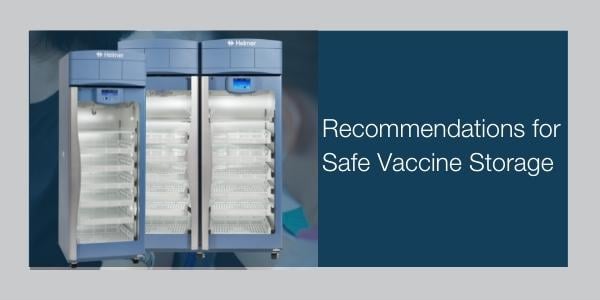The COVID-19 pandemic and subsequent mass-vaccination efforts have placed an increased emphasis (and increased accountability) on the proper storage and handling of refrigerated and frozen vaccines. Improper vaccine storage presents a significant risk to patient safety and public health as vaccine doses exposed to temperature excursions may lose potency.
Deviation from the recommended vaccine cold chain protocol also presents considerable financial risk to vaccine providers who may have to replace inventories, re-vaccinate patients, and, in some cases, face legal liability. For example, in June 2022, the Colorado Department of Public Health announced nearly 2,000 people in the Denver metro area needed to be re-vaccinated after an area clinic improperly stored vaccines at 63 sites.
Here are five best practices for proper vaccine storage to help ensure your vaccine doses are stored safely and remain potent:
1. Only store vaccines and diluents in professional medical-grade refrigerators and freezers
Professional medical-grade refrigerators and freezers, such as GX Solutions from Helmer Scientific, are specifically designed and engineered for the proper storage of vaccines. They are rigorously tested to maintain temperature stability throughout daily use in a busy pharmacy or clinic setting, often with multiple door openings per hour.
These units also come equipped with temperature monitoring devices and digital data loggers, as well as visual and audible alarms to alert users of power failures, temperature excursions, or open doors. Facilities should plan to have refrigerators and freezers with enough capacity to safely hold the year’s largest inventory.
2. Open, inspect, and properly store vaccines immediately upon receipt
Vaccine deliveries should be scheduled only when the vaccine coordinator or designated backup is present and available to fully complete the process of storing the vaccines for use.
Vaccines should be unpacked and assessed immediately upon receipt. First, assess the external packaging to ensure it is not damaged. Examine temperature indicators and confirm the quantities, lot numbers, and expiration dates match the packing slip. Not all shipments will include temperature indicators, so ensure the vaccines have been packed according to FDA-approved packing standards.
3. Follow the CDC Vaccine Storage and Handling Toolkit guidelines for vaccine inventory management
Vaccines and diluents should be stored in a dedicated refrigerator or freezer used exclusively for that purpose. Other frozen or refrigerated items should not be stored in units designated for vaccines.
Vaccines should be stored in their original boxes with lids closed to prevent unnecessary exposure to light. Vaccines for public use (VFC programs, etc.) and private stock vaccines should be labeled and stored accordingly.
Vaccines should be stored based on expiration date with those closest to expiration stored at the front of the cabinet and used first.
4. Appropriately arrange and group vaccines
Vaccines should be stored in breathable storage baskets (still in their original packaging) and labeled clearly.
Vaccines should be grouped and clearly marked by pediatric, adolescent, and adult types.
Vaccines should be grouped by state; freeze-dried and other vaccines requiring reconstitution should be stored with their diluents.
5. Account for proper air-flow requirements
Utilizing ventilated baskets and shelves supports proper air flow. Refrigerator and freezer cabinets should not be overcrowded, as a lack of space prevents proper airflow. At least 2-4 centimeters between boxes is recommended.
If vaccines are being stored in a combination refrigerator/freezer unit or a non-medical grade unit, there are a few additional steps to take to reduce the risk of temperature excursion. If using a combination unit, do not store any vaccines, even those meant to be stored frozen, in the freezer cabinet. Vaccines should also never be stored in refrigerator or freezer door shelves or in crisper drawers at the bottom of the cabinet.
If using a non-professional purpose-built unit, the top and bottom shelves should be avoided, and thermal ballasts should be added throughout the cabinet to assist with temperature stability.
Other Blogs You Might Be Interested In...
- Importance of Temperature Uniformity for Vaccine Storage
- Explaining the NSF / ANSI 456 Vaccine Storage Standard
- Where to Properly Place a Temperature Probe in Your Vaccine Refrigerator
- The Water Bottle Debate
From vaccine manufacture to arrival at the provider facility, management of the vaccine cold chain is the responsibility of the manufacturer. However, once vaccine inventories arrive at the provider facility, it is up to the provider to manage ongoing vaccine cold chain requirements, including proper storage and handling. Is your facility prepared?
Helmer has developed a white paper highlighting the temperature performance of two purpose-built vaccine storage units to provide additional context around the importance of choosing purpose-built vaccine storage units. It also highlights the requirements of the NSF / ANSI 456 Vaccine Storage Standard and the superiority of units certified to this standard.





